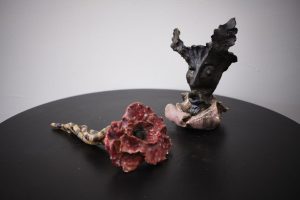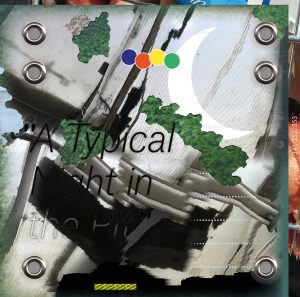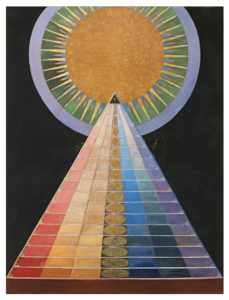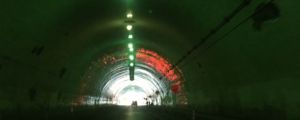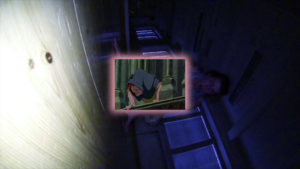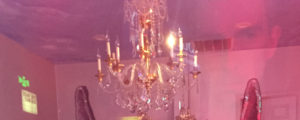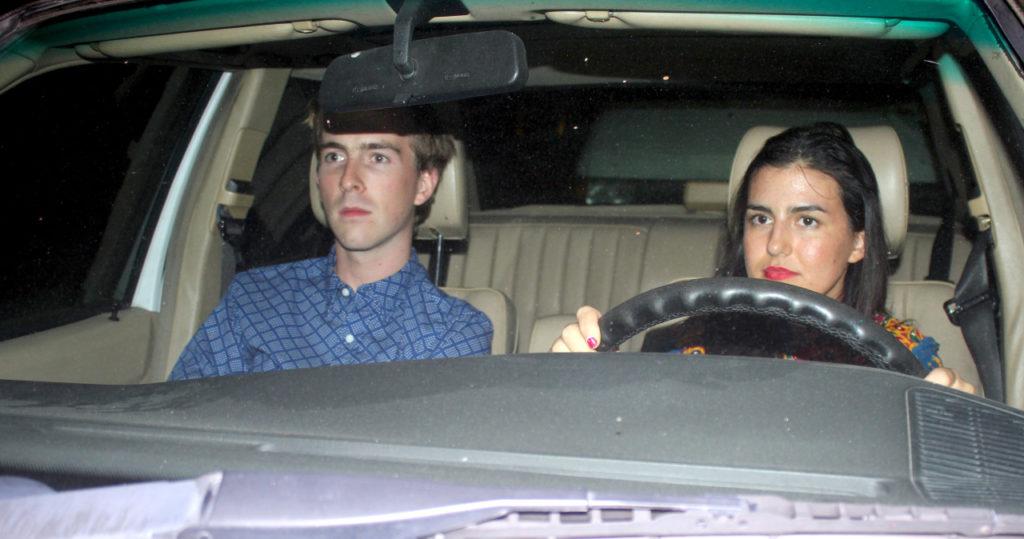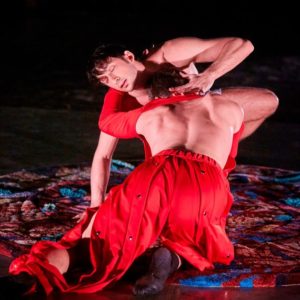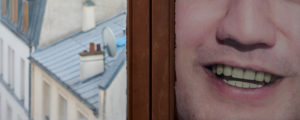What happens to the present when we’re stuck in the future? AQNB editor Jean Kay, and Video in Common (ViC) presented the ‘Staying Present’ screening, reading and discussion at Berlin’s Vierte Welt, as part of the Creamcake-organised 3hd Festival, on Wednesday October 12.
In referring to the title of this year’s festival topic ‘There is nothing left but the future?’ AQNB x ViC focussed on the question mark, interrogating what is actually meant by ‘the future’ and whether the past has a role in determining it. The programme presented artists, musicians and ideas drawing on convention and tradition to comment on the contemporary condition by integrating old aesthetics, formats, media, practices and logics into producing new work.
‘Act I, Scene II’ of Jaakko Pallasvuo‘s The Hunchback of South Bermondsey sound piece — originally produced for quarterly podcast Status Effect — opened the event with a glimpse into a near neofeudal future. Armed with an “iPod Shuffle, your Master’s degree, the keys to your apartment”, a character called Lancelot navigated a play and a scene full of “wizadry, alchemy, allurement, sorcery”, while London-based producer Klein talked about the influence of Gospel music and the internet on her visceral vocal ambient project in an AQNB x ViC editorial video production.
Meanwhile, Gary Fembot and Easter combined and conflated contemporary issues and ideas with traditionally transgressive queer-punk aesthetics and outdated filming techniques in excerpts of their respective ‘Scream of the Mandrake’ and Sadness is an Evil Gas Inside of Me videos. Maxwell Sterling laid fielded footage of Los Angeles’ surreal landscapes over his ‘Hollywood Medieval’ music production, while Institute for New Feeling looked into the oracle of the online in a custom massage chair and screen experience in ‘seek: a self-fulfilling prophesy’. Finally, writer, artist and witch Martha Windahl of MW Tarotscopes drew up an astrological chart prediction and joined the Berlin event from her base in Los Angeles to predict the future of Europe, live and via Skype.
‘Staying Present’ follows a series of previous events organised by AQNB and video production partner ViC in Berlin, London, and Los Angeles –all key cultural centres in the collaboration’s network. Titled ‘The Future Is Here, It’s Just Not Evenly Distributed’, ‘At the Backend’ and ‘Accessing Economies: Engagement & Withdrawal’ together these programmes interrogated the systems and infrastructures embedded in networked communication, and how this affects distribution, flows of information and power, as well as language, community-building, identity formation and assimilation.
Below is the full programme of video, audio and stills of the works presented in their running order:
Jaakko Pallasvuo: The Hunchback of South Bermondsey, ‘Act I, Scene II’ (2015) [27:17 min]
Helsinki-based artist Jaakko Pallasvuo explores a dystopic future with a view of the contemporary, as well as the past, in a co-production with Roy Boswell. The sound piece, drawing from three years of three different eras — 2555AD, 1677 AD, and 2015 AD — presents a narrated play that mixes and confuses historical signifiers, only to draw parallels between systems of power and hierarchy across ages.
Klein: ‘Key Changes’ (2016) [6:54 min]
London-based producer and performer Klein talks about her influences spanning the breadth of the internet, from Kim Burrell to Pavarotti, and how it feels to be a self-taught musician and artist being embraced by the greater “electronic realm”. Klein released her first EP Lagata on September 1, where she produces a unique blend of athletic vocal exercises that clash and combine with noisy ambience.
Gary Fembot: ‘Scream of the Mandrake’ (2015) [16:00 min]
San Francisco-based musician, director and zine-maker Gary ‘Fembot’ Gregerson bids farewell to the old days of his Bay Area city’s liberal activism and queer counter-culture, now overrun by Silicon Valley tech employees and bourgeois boutique lifestyles. Using blanched Super 8mm film, Sta-Prest and Puce Moment band member Fembot draws on a specific aesthetic tradition of San Francisco’s radical punk past, while revealing the hollow corporate sprawl left at its disemboweled core.
Easter: Sadness is an Evil Gas Inside of Me, Episode 4, ‘The Age of Corn’ (2015) [17:06 min]
Berlin-based art and music duo Stine Omar and Max Boss of Easter present what their press release, written by Vika Kirchenbauer, calls a “soap opera in the guise of an essay film”. The four-episode series produced between 2014 and 2015 stages a world described as being in “absence of present”, one where multiple pasts emerge through the subconscious and internal worlds of its characters. Filmed with a camcorder and narrated by queer icon Vaginal Davis, Sadness is an Evil Gas Inside of Me contrasts high quality sound with the low resolution video material to construct its own “ambiguous future”.
Maxwell Sterling: ‘Hollywood Medieval’ (2016) [7:32 min]
LA-based, Manchester-born musician and producer Maxwell Sterling takes his classical training in double-bass and experience in scoring film to produce live renditions of cult-producer James Ferraro‘s ‘Burning Prius’, as well as releasing his own music in recent album Hollywood Medieval on Los Angeles Memory No. 36 Recordings on August 6. Through cut-up and collaged images, and layered and augmented synthesiser samples and recordings, Sterling develops an audio-visual experience at the point where nature and the city collide.
Institute for New Feeling: ‘seek: a self-fulfilling prophesy’ (2016) [3:48 min]
Pittsburgh- and LA-based art collective Institute for New Feeling echo humanity’s age-old obsession with future-telling via the dystopian narrative of modern clairvoyance and its corporate co-option. A live personal session in a massage chair VR that uses personal internet search histories and online surveillance to produce a future reading, ‘seek: a self-fulfilling prophesy’ presents an oracle that offers a false sense of calm in the face of uncertainty.
Martha Windahl: Live Skype psychic Reading
LA-based artist, writer and witch Martha Windahl uses alternative logics and practices to make sense of a universe in chaos. Her ongoing performance and clairvoyant work emerged in the grip of the 2008 Global Economic Crisis, not only as a practical solution to fiscal insecurity but also in response to a growing demand for a new source of reason in an increasingly complex world.**

